CosyVoice 2: Scalable Streaming Speech Synthesis with Large Language Models
- 論文鏈接:https://arxiv.org/pdf/2412.10117
- 代碼鏈接:https://github.com/FunAudioLLM/CosyVoice
一句話總結
CosyVoice 2 是一款改進的流式語音合成模型,其核心創新包括采用有限標量量化(FSQ) 提升語音令牌的碼本利用率,簡化文本 - 語音語言模型架構以直接使用預訓練大語言模型(如 Qwen2.5-0.5B)作為骨干,以及開發塊感知因果流匹配模型,實現單一模型支持流式和非流式合成。通過在大規模多語言數據集(中文 130,000 小時、英文 30,000 小時等)上訓練,該模型達到人類 parity 自然度,流式模式下響應延遲極低且合成質量幾乎無損,在內容一致性(WER 低至 2.45%)、 speaker 相似度(最高 0.812)和語音質量(NMOS 達 3.96)上表現優異,同時支持情感、口音等精細指令控制。
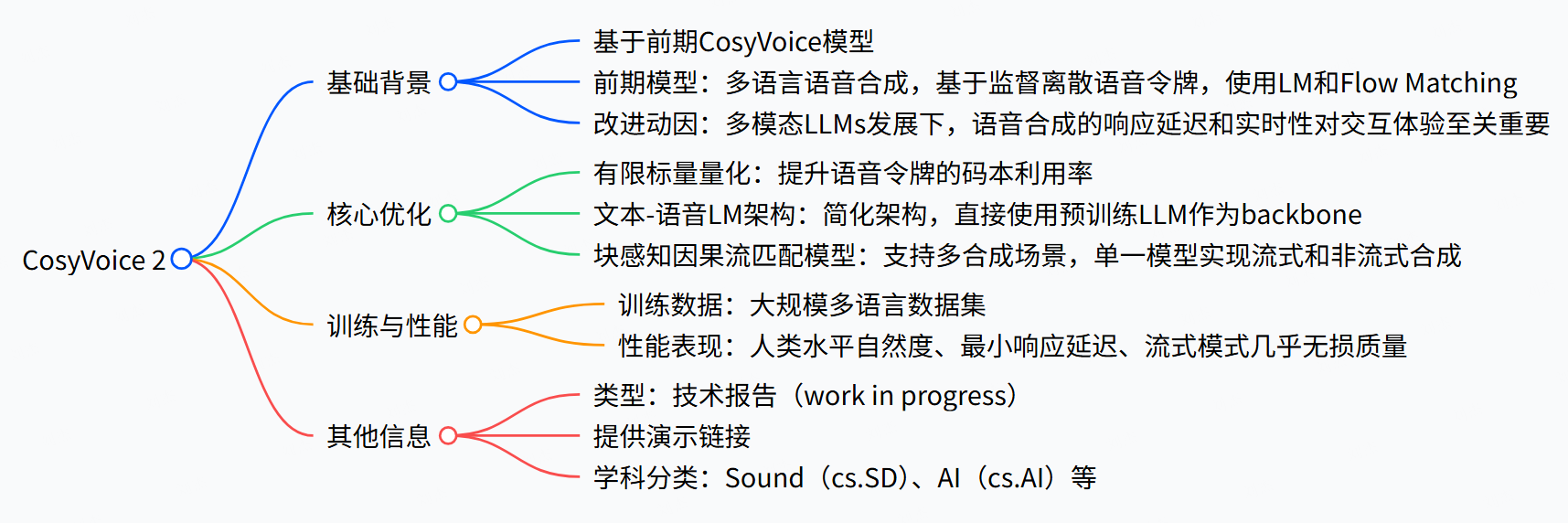
模型結構
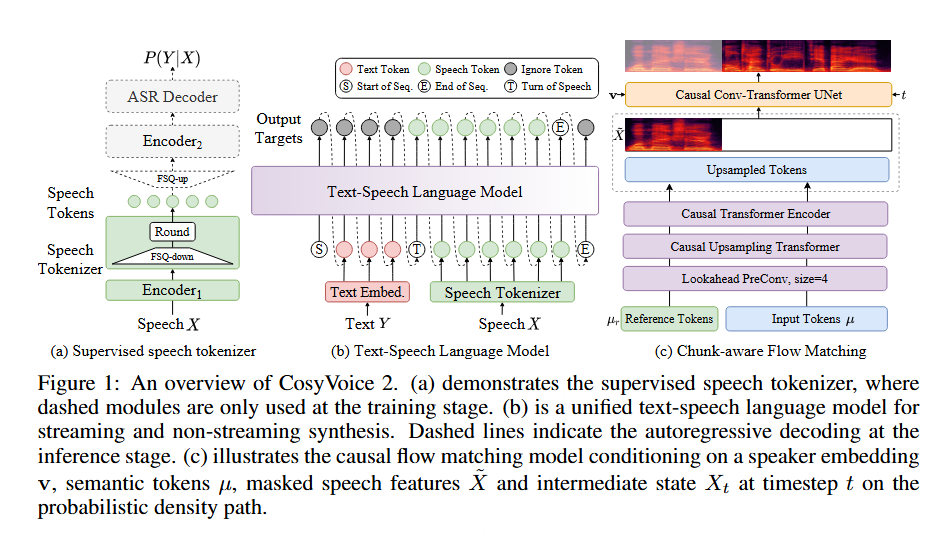
核心創新
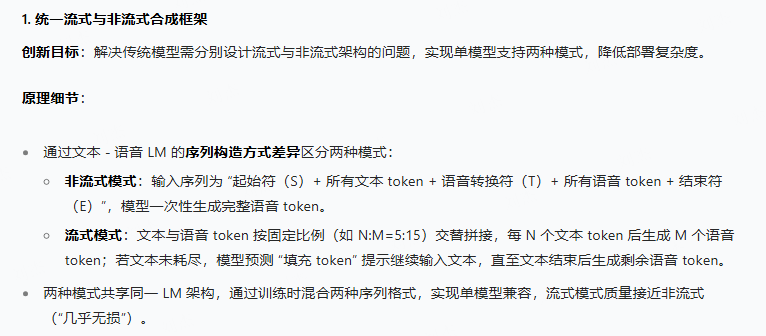
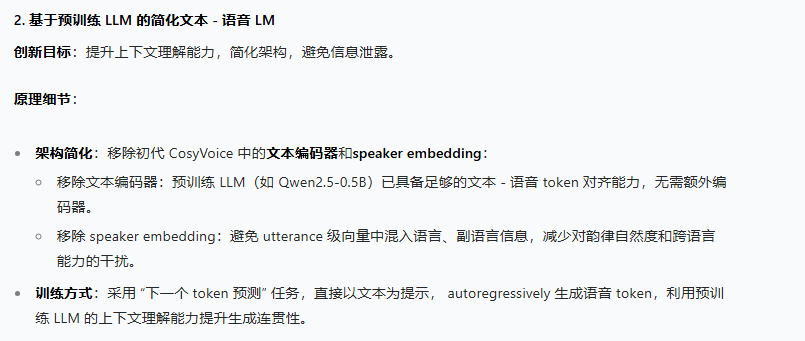
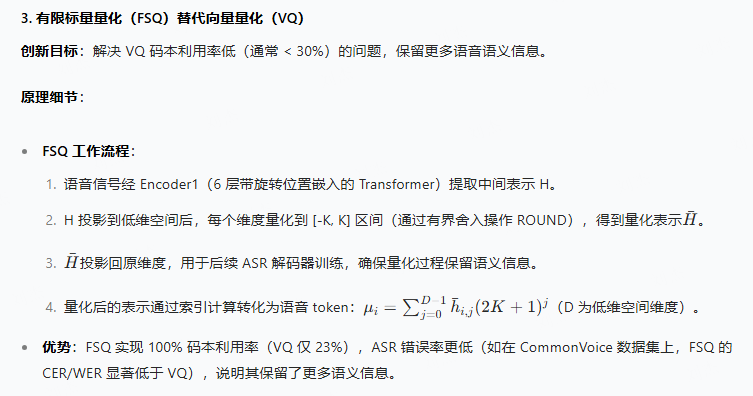
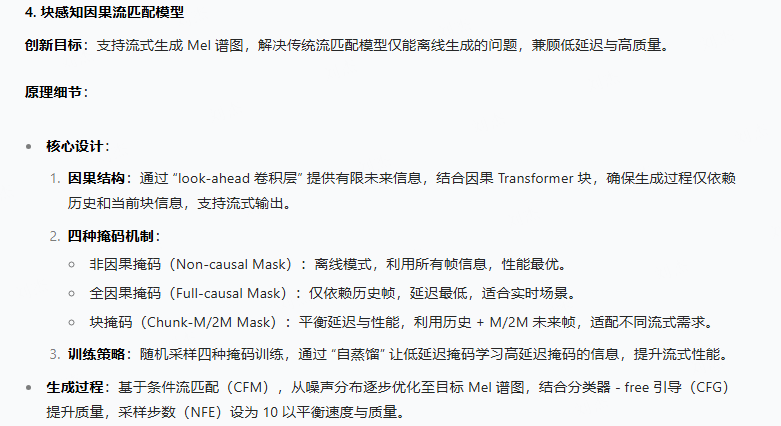
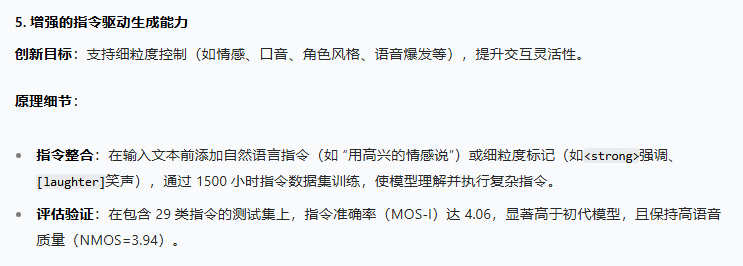
實驗數據
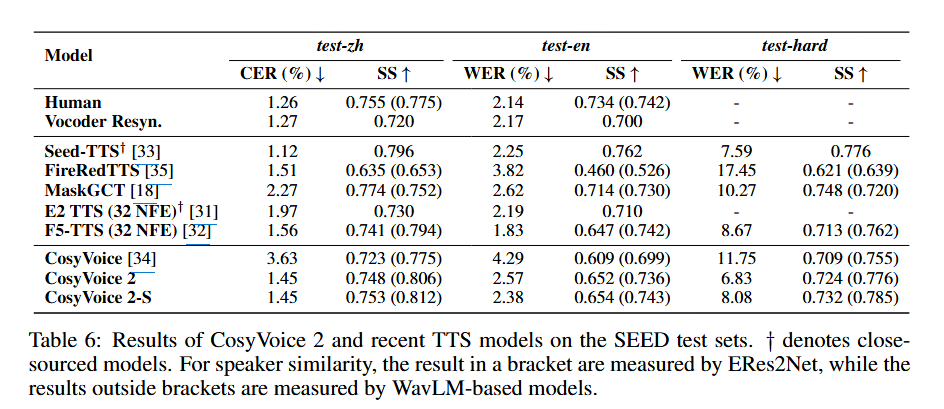
核心代碼塊解讀
語音token和文本token是如何兼容輸入的
見cosyvoice/llm/llm.py
@torch.inference_mode()def inference(self,text: torch.Tensor,text_len: torch.Tensor,prompt_text: torch.Tensor,prompt_text_len: torch.Tensor,prompt_speech_token: torch.Tensor,prompt_speech_token_len: torch.Tensor,embedding: torch.Tensor,sampling: int = 25,max_token_text_ratio: float = 20,min_token_text_ratio: float = 2,uuid: str = '',) -> Generator[torch.Tensor, None, None]:device = text.devicetext = torch.concat([prompt_text, text], dim=1)print('text: ', text.shape, )text_len += prompt_text_lentext = self.llm.model.model.embed_tokens(text)# 3. concat llm_inputsos_eos_emb = self.llm_embedding.weight[self.sos_eos].reshape(1, 1, -1)task_id_emb = self.llm_embedding.weight[self.task_id].reshape(1, 1, -1)if prompt_speech_token_len != 0:prompt_speech_token_emb = self.speech_embedding(prompt_speech_token)else:prompt_speech_token_emb = torch.zeros(1, 0, self.llm_input_size, dtype=text.dtype).to(device)lm_input = torch.concat([sos_eos_emb, text, task_id_emb, prompt_speech_token_emb], dim=1)# 4. cal min/max_lengthmin_len = int((text_len - prompt_text_len) * min_token_text_ratio)max_len = int((text_len - prompt_text_len) * max_token_text_ratio)# 5. step by step decodefor token in self.inference_wrapper(lm_input, sampling, min_len, max_len, uuid):yield token
主要內容:
- 把prompt文本和輸入文本拼接
text = torch.concat([prompt_text, text], dim=1) - 文本embedding映射
text = self.llm.model.model.embed_tokens(text) - speech prompt token 映射:
prompt_speech_token_emb = self.speech_embedding(prompt_speech_token) - token embedding映射后拼接:
lm_input = torch.concat([sos_eos_emb, text, task_id_emb, prompt_speech_token_emb], dim=1) - 輸入到模型中,做 Next token prediction
怎么在 text prompt 里面做 instruct 的
見 cosyvoice/cli/frontend.py
def frontend_instruct2(self, tts_text, instruct_text, prompt_speech_16k, resample_rate, zero_shot_spk_id):model_input = self.frontend_zero_shot(tts_text, instruct_text + '<|endofprompt|>', prompt_speech_16k, resample_rate, zero_shot_spk_id)del model_input['llm_prompt_speech_token']del model_input['llm_prompt_speech_token_len']return model_input做法非常樸素,就是直接把 instruct_text + '<|endofprompt|>' 作為 prompt text 輸入。值得注意的是,這種情況下,llm_prompt_speech_token 是會被刪除的,那么如果音色和semantic token 不解耦的情況下,是否會導致一些音色不相似問題。
如何做文本音頻混合流式
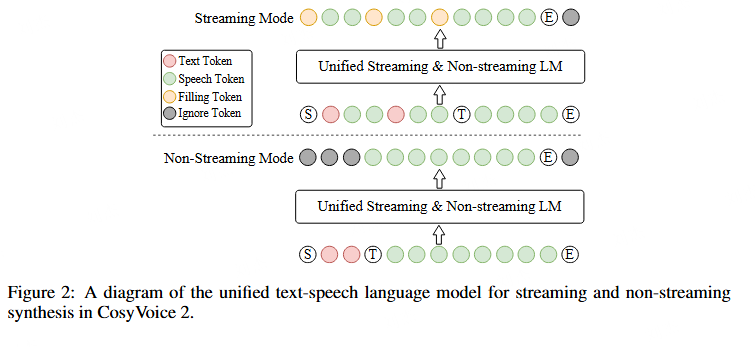
def prepare_lm_input_target(self, text_token, text_token_emb, text_token_len, speech_token, speech_token_emb, speech_token_len):lm_target, lm_input = [], []text_token = unpad_sequence(text_token, text_token_len.cpu(), batch_first=True)speech_token = unpad_sequence(speech_token, speech_token_len.cpu(), batch_first=True)text_token_emb = unpad_sequence(text_token_emb, text_token_len.cpu(), batch_first=True)speech_token_emb = unpad_sequence(speech_token_emb, speech_token_len.cpu(), batch_first=True)for i in range(len(text_token)):# bistream sequenceif random.random() < 0.5 and speech_token_len[i] / text_token_len[i] > self.mix_ratio[1] / self.mix_ratio[0]: # 滿足音頻大于text的倍數長度關系this_lm_target, this_lm_input = [], []this_lm_target.append(IGNORE_ID)this_lm_input.append(self.llm_embedding.weight[self.sos_eos].reshape(1, -1))for j in range(((text_token_len[i] + 1) / self.mix_ratio[0]).ceil().int().item()):this_text_token = text_token[i][j * self.mix_ratio[0]: (j + 1) * self.mix_ratio[0]].tolist() # 每mix_radio(5)個文本token切成一個塊this_speech_token = speech_token[i][j * self.mix_ratio[1]: (j + 1) * self.mix_ratio[1]].tolist() # 每mix_radio(15)個語音token切成一個塊if len(this_text_token) == self.mix_ratio[0]:assert len(this_speech_token) == self.mix_ratio[1]this_lm_target += [IGNORE_ID] * (self.mix_ratio[0] - 1)this_lm_target += this_speech_token # target: ignore_id * (5-1) + 15個語音tokenthis_lm_target.append(self.speech_token_size + 2) # target: + eosthis_lm_input.append(text_token_emb[i][j * self.mix_ratio[0]: (j + 1) * self.mix_ratio[0]]) # input: 5個文本token對應的embeddingthis_lm_input.append(speech_token_emb[i][j * self.mix_ratio[1]: (j + 1) * self.mix_ratio[1]]) # input: + 15個語音token對應的embeddingelse:# 處理最后一個文本token不足5個的情況this_lm_target += [-1] * len(this_text_token)this_lm_target += speech_token[i][j * self.mix_ratio[1]:].tolist()this_lm_target.append(self.speech_token_size)this_lm_input.append(text_token_emb[i][j * self.mix_ratio[0]:])this_lm_input.append(self.llm_embedding.weight[self.task_id].reshape(1, -1))this_lm_input.append(speech_token_emb[i][j * self.mix_ratio[1]:])# 整體上target是token, input是embeddingthis_lm_target, this_lm_input = torch.tensor(this_lm_target), torch.concat(this_lm_input, dim=0)# unistream sequenceelse:this_lm_target = torch.tensor([IGNORE_ID] * (1 + text_token_len[i]) + speech_token[i].tolist() + [self.speech_token_size])this_lm_input = torch.concat([self.llm_embedding.weight[self.sos_eos].reshape(1, -1), text_token_emb[i],self.llm_embedding.weight[self.task_id].reshape(1, -1), speech_token_emb[i]], dim=0)lm_target.append(this_lm_target)lm_input.append(this_lm_input)lm_input_len = torch.tensor([i.size(0) for i in lm_input], dtype=torch.int32)lm_input = pad_sequence(lm_input, batch_first=True, padding_value=IGNORE_ID)lm_target = pad_sequence(lm_target, batch_first=True, padding_value=IGNORE_ID)return lm_target, lm_input, lm_input_len
見 cosyvoice/llm/llm.py
chunk aware flow-matching
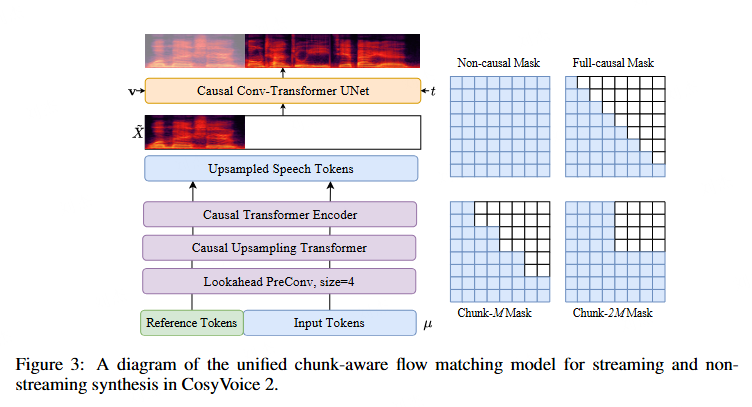
兩個核心點:
- 由于 semantic token 到 mel 的映射使用的是因果的 transformer(即只能看到之前的信息,用 mask 實現的),所以可以用過 mask 來控制因果長度,即上圖提到的 chunk mask
- 由于 flow-matching 需要多步計算,直接把 unet 做成多次循環,看為多步計算。
遺留問題
- instruct text 和 prompt text 的混用,只用
<|endofprompt|>標識做區分,模型會混淆嗎?而且,llm_prompt_speech_token被刪除,會導致音色一致性變差嗎?(根本的問題是 semantic token 是否能跟音色完全解耦),這種設計是否需要優化,或者在訓練模式上是否需要調整。 - 文本和音頻按N:M的比例混合訓練,這種方式是否是比較合理的方式,因為N:M不能保證音頻和文本token一定對應,這是個問題。有沒有更好的設計方式?
- chunk flow-matching 的訓練設計比較麻煩,整體上有沒有更簡潔的方案?

)







)
)




+實例測試)



